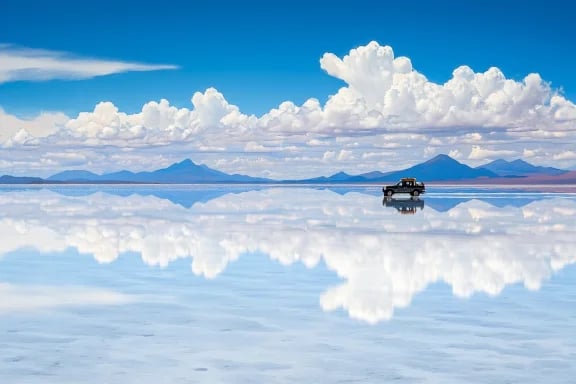Salar de Uyuni: Bolivia’s Blinding, Baffling, Beautiful Infinity
A landscape too symmetrical, too spotless, too… blank to be real. And then you step out of the Jeep and realize: this is not a mirage. This is the Salar de Uyuni, the largest salt flat on Earth-11,000 square kilometers of crystalline, otherworldly weirdness at nearly 12,000 feet above sea level.
ECHOES OF ELSEWHEREUNESCOSOUTH AMERICABOLIVIANATURAL ATTRACTIONNATURENATIONAL PARK


Southwestern Bolivia
At first, it feels like a trick of the light. A landscape too symmetrical, too spotless, too… blank to be real. And then you step out of the Jeep and realize: this is not a mirage. This is the Salar de Uyuni, the largest salt flat on Earth-11,000 square kilometers of crystalline, otherworldly weirdness at nearly 12,000 feet above sea level.
It’s like walking across the sky. Or inside a snow globe without the snow. Or on top of a frozen alien lake where the laws of physics took a sabbatical.
Welcome to Bolivia’s white wonderland, a place where the horizon disappears, the clouds have reflections, and your brain-frankly-doesn’t know what to do with itself. Whether you’re Googling “Salar de Uyuni tours,” “when to see the mirror effect,” or “is it safe to lick the ground?” (spoiler: don’t), you’re on the right salty path.
What Is Salar de Uyuni (Besides Pure Magic)?
Technically speaking, Salar de Uyuni is a prehistoric lake bed, left behind when ancient Lago Minchin dried up thousands of years ago. What remains is a staggering expanse of pure white salt crust, in some places over 10 meters deep. The surface is polygonal and geometric in dry season, reflective and surreal in wet season, and always 100% unfiltered brilliance.
It’s also, for the record, sitting on top of one of the world’s richest lithium deposits. But don’t worry-this blog is all about photos and dreams, not geopolitics or battery production.
How to Get There (Hint: There Will Be Jeeps)
The gateway to Salar de Uyuni is the modest town of Uyuni, which feels like a Western film set with slightly more backpackers and a lot more quinoa.
Fly into Uyuni from La Paz (approx. 1 hour)-quick, scenic, and occasionally turbulent.
Train or bus from Oruro or La Paz-adventurous, budget-friendly, and a bit bumpy.
Multi-day tour from Tupiza, La Paz, or even San Pedro de Atacama (Chile)-perfect if you want to combine surreal desert landscapes with thermal springs, geysers, and colored lakes.
From Uyuni, tours typically begin early and end when you’ve filled every memory card and ruined your sense of scale.
What to See and Do on the Salar de Uyuni Tour
1. Take the Most Ridiculous Perspective Photos Ever
Because the salt flat is so vast and featureless, you can stage wildly entertaining photos: people stepping on each other, dinosaurs chasing Jeeps, tiny people in Pringles cans. It’s like Instagram, but everyone’s five inches tall and laughing hysterically.
2. Witness the Mirror Effect (Rainy Season Only)
From December to March, shallow water covers the salt flat, turning it into a perfect reflection of the sky. It’s hard to say where the Earth ends and the heavens begin. Pro tip: wear waterproof shoes, or go barefoot like a minimalist philosopher.
3. Visit Isla Incahuasi (a.k.a. Cactus Island)
A fossilized coral reef in the middle of the salt desert, covered in towering cacti and framed by endless white. Climb to the top and feel like a lonesome space cowboy on a prickly little planet.
4. Stop by the Train Graveyard (Cementerio de Trenes)
Just outside Uyuni, this rusted symphony of 19th-century locomotives sits abandoned in the desert, baking in the sun and posing for moody photos. It’s Mad Max meets steampunk nostalgia.
5. Stay Overnight in a Salt Hotel
Yes, some lodgings are made entirely of salt blocks: walls, floors, beds, and even some furniture. No, you shouldn’t lick them. But yes, you should definitely brag about it later.
When to Go: Dry or Reflective?
You’ve got two moods to choose from, and both are spellbinding:
Dry Season (May to November): Expect blue skies, crystal-clear hexagonal salt patterns, epic perspective tricks, and easy driving conditions. The Salar looks like Earth’s most Instagrammable mosaic.
Wet Season (December to April): The thin water layer creates the mirror effect. Just be warned-flooding can limit access to parts of the flats, and yes, your ankles may get cold.
Can’t decide? Go in late April, when you might catch both worlds at once.
What to Bring (Besides a Wide-Angle Lens and Low Expectations for Reality)
Sunglasses: Essential. The glare from the salt is brutal.
Layers: Evenings get freezing cold-even in summer. And the sun at altitude doesn’t mess around.
Lip balm and lotion: The air is drier than a sarcasm seminar.
Water and snacks: Especially if you're on a budget tour. You’ll get fed, but high-altitude appetites are real.
Props: Tiny dinosaur figurines, rubber ducks, action figures-whatever you need for those mind-bending perspective photos.
Motion sickness pills: Some roads are more enthusiastic than paved.
Where to Stay in Uyuni and Beyond
Uyuni Town: Basic but convenient. Expect hot water, llama steak, and Wi-Fi that functions best if you believe in it hard enough.
Colchani: Closer to the salt flat, with several unique salt hotels like Palacio de Sal or Luna Salada offering dreamy views and crystallized décor.
Tayka Hotels (if on an extended tour): Ecolodges in the Eduardo Avaroa Reserve with remote locations, star-studded skies, and heating systems that you’ll thank profusely.
Fun Questions People Actually Ask
Is it safe to walk on the salt?
Yes. Unless it’s raining heavily or you’ve wandered off the guided path. Stick with your guide and don’t go full Bear Grylls.
Can I drive a rental car across the salt flats?
In theory, yes. In practice, absolutely not recommended. The flats are disorienting, remote, and merciless if you break down. Hire a guide. Preferably one who knows which patch of white is actually a mud trap.
Is there Wi-Fi?
Technically? Sometimes. But really, the only thing connecting out here is your soul to the sky.
Can you really fry an egg on the salt?
No, but it’s an amusing myth. The sun is strong, but it’s not a stovetop. Stick to metaphorical sizzle.
Final Thought: Earth’s Most Improbable Wonderland
Salar de Uyuni doesn’t make sense-and that’s its superpower. It’s not just beautiful. It’s unreasonable, the kind of beauty that has no right to exist and yet sprawls endlessly before you in crystalline silence.
It’s a place where the ground reflects the sky, your footprints vanish behind you, and for a few fleeting hours, you’re not entirely sure which way is up. But that’s the thing-you don’t come to Salar de Uyuni for answers. You come for wonder.




